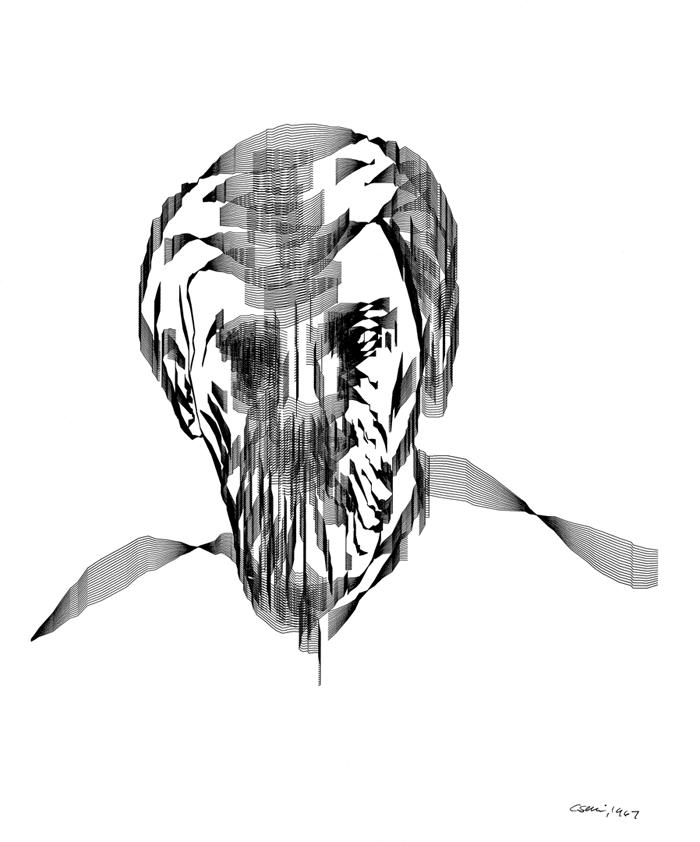A new, advanced service offered by the Ohio Supercomputer Center leverages the unique computing properties of the Graphics Processing Unit (GPU) to provide a robust visualization environment to researchers in fields as diverse as biomedicine, electrosciences and the animation arts.
 |
|
|
Sine Curve Man - Charles Csuri 1967 - Csuri’s drawing of a bearded man gained acclaim when the artist imaginatively transformed it using the sine curve function. In 1967, it won the Computers and Automation contest. |
|
|
OSC recently completed deployment of the “Csuri” Advanced GPU environment, increasing the Center’s capabilities for advanced large-scale remote visualization and batch-rendering applications, as well as GPGPU applications. This powerful computing environment is now available to all Ohio college and university faculty, students and staff, as is an upcoming workshop planned to provide insights on the effective use of the service.
The high performance computing (HPC) community is aggressively exploring general-purpose GPU (GPGPU) computing by using them as “many-core processors” to solve scientific problems. Modern, commercially available central processing units (CPUs) are multi-core processors with 2, 4 or 8 independent processors on a single chip. Many-core processors, on the other hand, have hundreds or thousands of processors that are more tightly connected.
“For the right kind of problems, GPGPU computing can provide revolutionary performance advantages,” said David Hudak, Ph.D., program director of cyberinfrastructure and software development at OSC. “The Csuri platform is designed to support the development of both GPGPU and advanced visualization solutions. We look forward to working with our user communities to develop codes and evaluate GPU-enabled third party applications.”
One example of the work that can benefit from the Csuri Advanced GPU environment is the work of its namesake, Charles “Chuck” Csuri, whose sophisticated digital art involves giant rendering of thousands of frames.
Csuri is best known as the father of computer graphics, computer animation and digital fine art, creating the first computer art in the 1960s. In addition to being recognized by the Smithsonian Magazine, Csuri is seen as a pioneer of computer animation by the Museum of Modern Art (MOMA) and the Association for Computing Machinery Special Interest Group Graphics (ACM-SIGGRAPH).
Csuri became interested in the digital computer as a means of imaging in 1964, when he saw a computer-generated face in a publication from the university’s department of electrical engineering. While a senior professor at The Ohio State University (OSU), Csuri founded the Computer Graphics Research Group, the OSC Graphics Project and accad, an academic unit dedicated to the development of digital art and computer animation.
During the beta testing of the GPU system, Umit Catalyurek, Ph.D., associate professor in the Department of Biomedical Informatics and Department of Electrical and Computer Engineering at OSU, used the nodes to develop a component-based runtime system for various biomedical image analyses and synthetic aperture radar image formations.
“One of student researchers is using the new GPU system to finish his experiments for a project on automatic tuning of radar signal processing on emergent architectures,” said Catalyurek. “We are now developing software systems that will enable applications to easily scale from a single CPU or GPU to a cluster of GPUs and multicore CPUs.”
With matching funding from DaytaOhio, a Wright Center of Innovation, OSC was able to develop the Csuri Advanced GPU Environment with the latest NVIDIA visualization technology, providing researchers with 18 NVIDIA Quadro Plex 2200 S4 units installed in the Center’s flagship production cluster, the Glenn IBM 1350, and 16 nVidia C1060 cards installed in the BALE research cluster. The GPU environment also features the CUDA toolkit, including the CUDA SDK, a collection of example programs illustrating various aspects of CUDA and GPGPU usage.